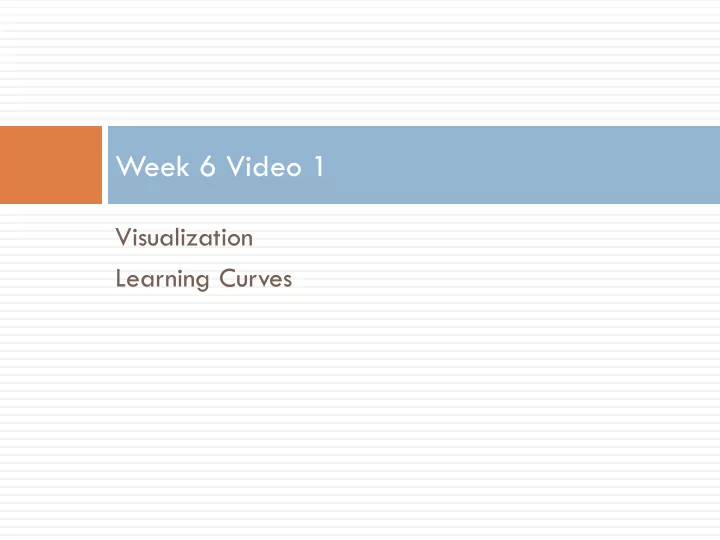

Week 6 Video 1 Visualization Learning Curves
Visualization ¨ Displaying information in a meaningful fashion
Visualization Should… (Tufte, 1983) ¨ Show the data ¨ Induce the viewer to think about the substance ¨ Avoid distorting what the data have to say ¨ Make large data sets coherent ¨ Encourage the eye to compare different pieces of data ¨ Reveal the data at several levels ¨ (And other stuff too)
Visualization ¨ A big area ¨ Worthy of a course in its own right ¨ Rather than discussing standard visualizations ¨ I’ll discuss a few visualizations that are particularly important with educational data
Learning Curves ¨ One of the most important visualizations in education ¨ Briefly discussed in Week 4 ¨ I’ll go into more depth today
The Classic Learning Curve
Assumptions ¨ The student is practicing the same skill several times in (approximately) the same fashion ¨ Completing a physics problem set ¨ Reading the same word in several stories ¨ Learning to complete an assembly line procedure ¤ Early application! (Crossman, 1959)
Assumptions ¨ Similar methods and considerations apply to situations where the student is recalling the same knowledge several times
Assumptions ¨ We have some way to measure student performance over time ¤ Speed or accuracy
Learning LISP programming in the LISP Tutor (Corbett & Anderson, 1995)
Learning in Cognitive Tutor Geometry (Ritter et al., 2007)
A certain characteristic pattern
Power Law of Learning* ¨ Performance (both speed and accuracy) improves with a power function * -- May actually be an exponential function rather than a power function (Heathcote, Brown, & Mewhort, 2000)
Called Power Law ¨ Because speed and accuracy both follow a power curve ¨ Radical improvement at first which slows over time towards an asymptote ¨ Passing the asymptote usually involves developing entirely new strategy
Passing the Asymptote ¨ Famous example: Fosbury Flop • http://www.youtube.com/watch?v=Id4W6VA0uLc
Power Law of Learning proven to apply across many domains ¨ Simple domains ¤ Pressing correct button on stimulus ¨ Complex problem-solving domains ¤ Math ¤ Programming ¨ Real-world domains ¤ Cigar-making in factories (Crossman, 1959)
Real-world data ¨ Are rarely perfectly smooth… ¨ (At least not without hundreds of students or more)
Example from a minute ago
Making inference from learning curves
Making inference from learning curves ¨ Via visual inspection of the curve form
“Normal learning”
No learning going on
What might this graph mean? 2.5 2 1.5 1 0.5 0 1 2 3 4 5 6 7 8 9 10 11 12 13 14 15 16 17 18 19 20 21 22 23 24 25 26 27
Insert Pause-Continue Quiz Here 2.5 2 1.5 1 0.5 0 1 2 3 4 5 6 7 8 9 10 11 12 13 14 15 16 17 18 19 20 21 22 23 24 25 26 27
Student has already learned skill for the most part 2.5 2 1.5 1 0.5 0 1 2 3 4 5 6 7 8 9 10 11 12 13 14 15 16 17 18 19 20 21 22 23 24 25 26 27
What might this graph mean? 30 25 20 15 10 5 0 9 10 11 12 13 14 15 16 17 18 19 20 21 22 23 24 25 26 27 28 29 30 31 32 33 34 35 36 37 1 2 3 4 5 6 7 8
Insert Pause-Continue Quiz Here 30 25 20 15 10 5 0 9 10 11 12 13 14 15 16 17 18 19 20 21 22 23 24 25 26 27 28 29 30 31 32 33 34 35 36 37 1 2 3 4 5 6 7 8
Student learned a new strategy and “broke through” the asymptote 30 25 20 15 10 5 0 9 10 11 12 13 14 15 16 17 18 19 20 21 22 23 24 25 26 27 28 29 30 31 32 33 34 35 36 37 1 2 3 4 5 6 7 8
What might this graph mean? 25 20 15 10 5 0 1 2 3 4 5 6 7 8 9 10 11 12 13 14 15 16 17 18 19 20
Insert Pause-Continue Quiz Here4 25 20 15 10 5 0 1 2 3 4 5 6 7 8 9 10 11 12 13 14 15 16 17 18 19 20
Two skills treated as the same skill (Corbett & Anderson, 1995) 25 20 15 10 5 0 1 2 3 4 5 6 7 8 9 10 11 12 13 14 15 16 17 18 19 20
Uses ¨ To understand how (and whether) a skill is being learned across students
Uses ¨ To study and refine item-skill mappings in educational software ¨ As discussed in week 4, Pittsburgh Science of Learning Center DataShop (Koedinger et al., 2010) is a common tool for doing this
Week 6 Video 1 Visualization Learning Curves
Recommend
More recommend